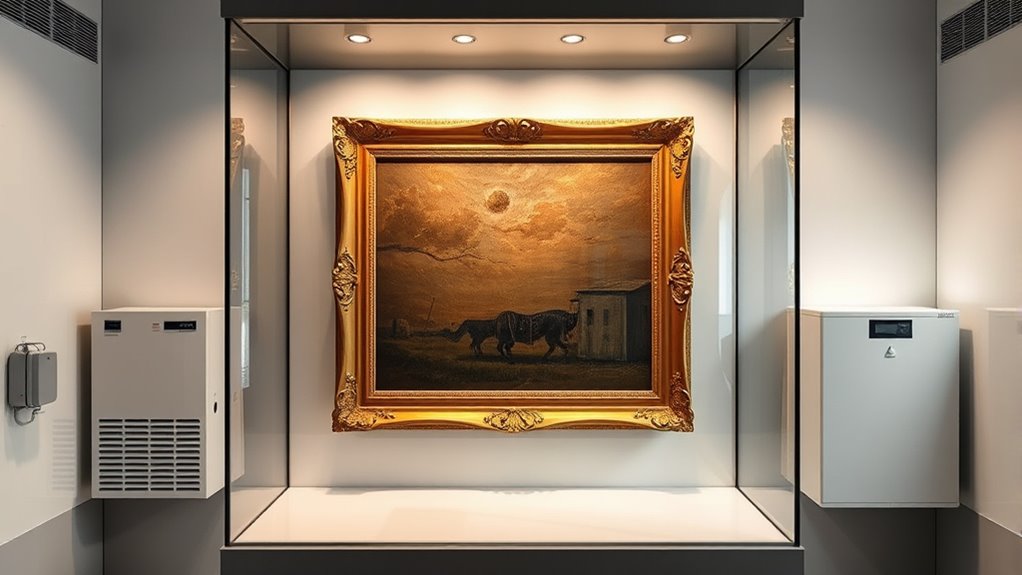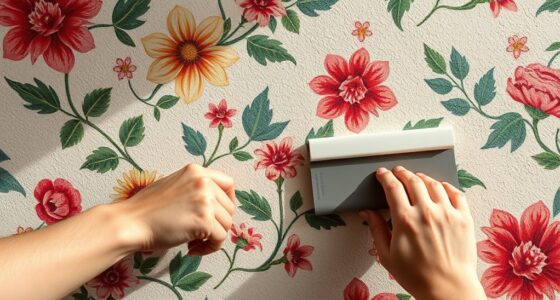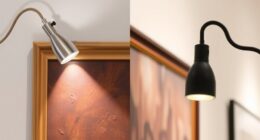To protect art in humid rooms, you should control environmental factors by using dehumidifiers and ensuring proper ventilation to maintain stable moisture levels. Regularly monitor humidity with hygrometers and inspect your artwork for signs of damage or mold. Use suitable framing materials and airtight sealants to prevent moisture infiltration. Store artworks in acid-free containers and implement quick response plans for sudden humidity changes. Continue exploring for more practical tips to preserve your collection effectively.
Key Takeaways
- Maintain indoor humidity levels between 40-50% using dehumidifiers and climate control systems.
- Carefully place moisture sensors near vulnerable areas to monitor fluctuations and prevent damage.
- Use mold-resistant sealants and proper framing materials to protect artwork from moisture infiltration.
- Regularly inspect and calibrate humidity control devices to ensure stable environmental conditions.
- Store artwork in acid-free, ventilated containers and avoid exposure to direct sunlight and heat sources.
Understanding Humidity and Its Impact on Art
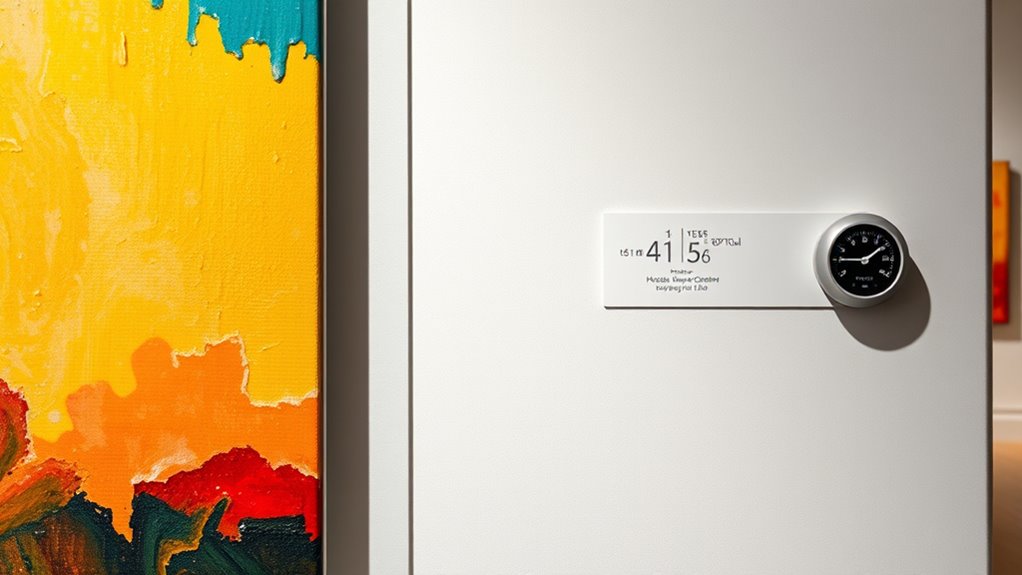
Have you ever wondered why humidity levels matter so much for artwork? Proper humidity control is essential for art conservation because fluctuations can cause materials to expand, contract, or crack. Too much moisture in the air accelerates deterioration, fostering mold growth and weakening paper, paint, and wood. Conversely, low humidity makes surfaces brittle, increasing the risk of flaking or breaking. Maintaining stable moisture levels helps preserve the integrity of your artwork over time. Understanding the impact of humidity allows you to implement effective conservation strategies, ensuring your pieces remain in ideal condition. For example, color accuracy can be compromised by environmental factors, which underscores the importance of consistent humidity control. Implementing environmental monitoring tools can help track and maintain optimal humidity levels. Additionally, humidity regulation devices can help create a stable environment, especially in spaces prone to environmental fluctuations. Using a dedicated air purifier with appropriate filtration can also reduce airborne pollutants that may contribute to surface degradation. Whether in galleries, museums, or your home, controlling humidity is key to protecting your art from the damaging effects of environmental fluctuations.
Monitoring and Measuring Moisture Levels
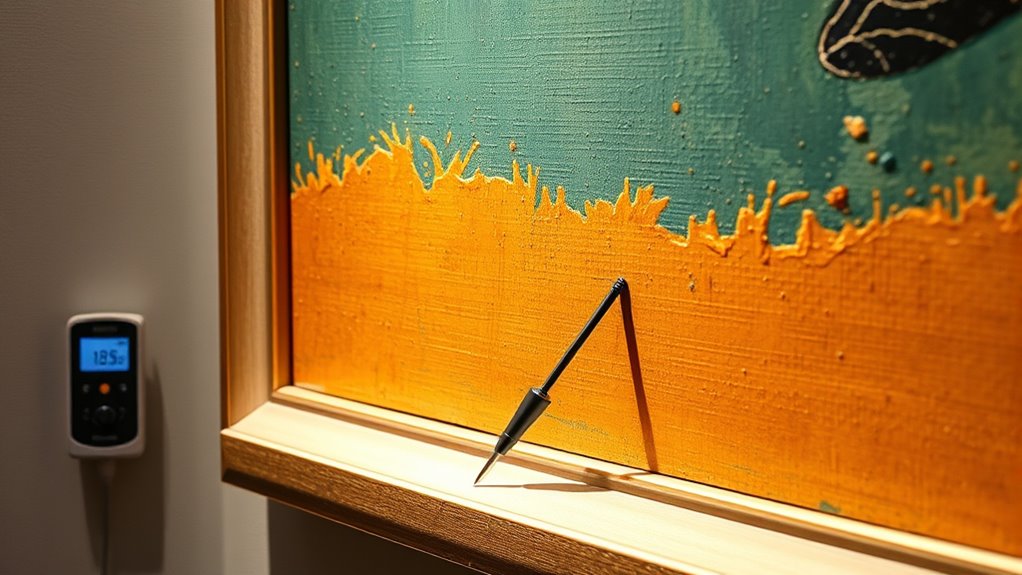
You need to place sensors carefully to get accurate moisture readings without damaging the artwork. Once you have the data, it’s important to interpret it correctly to identify potential risks. Properly understanding moisture levels helps you take timely actions to protect your art. Regularly monitoring air quality indicators ensures that humidity remains within safe ranges for delicate items. Additionally, choosing the right sensor placement is crucial to avoid inaccuracies caused by obstructed airflow or external influences. Implementing AI detection methods can further enhance the accuracy of moisture level assessments by analyzing patterns over time. Incorporating expert advice can also assist in optimizing your monitoring strategies to better preserve your collection.
Optimal Sensor Placement
To effectively monitor moisture levels in artwork, placing sensors in strategic locations is essential. Proper placement guarantees accurate readings and reliable data logging. Consider these key points:
- Position sensors near vulnerable areas like corners or existing cracks where moisture tends to accumulate.
- Place sensors at different heights to detect vertical moisture variations, aiding in early detection.
- Regularly check sensor calibration to maintain measurement accuracy over time.
- Incorporating sensor upgrades can improve detection sensitivity and longevity in humid environments. Additionally, understanding humidity control techniques can help maintain optimal conditions for artwork preservation.
- Ensuring proper sensor placement can prevent false readings and provide a comprehensive overview of moisture distribution within the room.
- Monitoring humidity fluctuations over time allows for better adjustment of environmental controls, helping to protect delicate art pieces from damage.
Interpreting Moisture Data
Interpreting moisture data accurately is vital for protecting artwork from damage. When you analyze readings, consider how humidity fluctuations can affect artistic techniques and the integrity of historical preservation efforts. Look for patterns that indicate sustained high or low moisture levels, which can cause paint cracking, warping, or mold growth. Use calibrated tools and compare data over time to identify trends. Understanding moisture data helps you make informed decisions about climate control adjustments. It’s also essential to interpret readings within the context of the artwork’s materials and age. By accurately assessing moisture levels, you support the long-term preservation of art, ensuring that delicate surfaces and historical details remain intact for future generations. Regular monitoring and measurement of moisture levels with appropriate tools is crucial for effective preservation strategies.
Controlling Indoor Humidity With Dehumidifiers and Ventilation

Maintaining proper indoor humidity levels is essential for preserving the integrity of artwork, and using dehumidifiers alongside effective ventilation is one of the most efficient ways to accomplish this. Proper climate control prevents mold, warping, and deterioration. To optimize your efforts, consider these key actions:
Maintaining proper humidity with dehumidifiers and ventilation preserves artwork and prevents damage.
- Use a dehumidifier to keep humidity between 40-50%, ideal for art conservation.
- Ensure good ventilation by regularly airing out the room to prevent stale, moist air.
- Monitor humidity levels with a hygrometer to adjust your climate control tools promptly.
- Incorporating indoor climate management strategies can further enhance your efforts in protecting artwork, especially when considering reliable backup power solutions to ensure continuous climate control during outages.
- Employing automation in climate control systems can help maintain stable conditions with minimal manual intervention.
Selecting Suitable Materials and Framing for Humid Environments
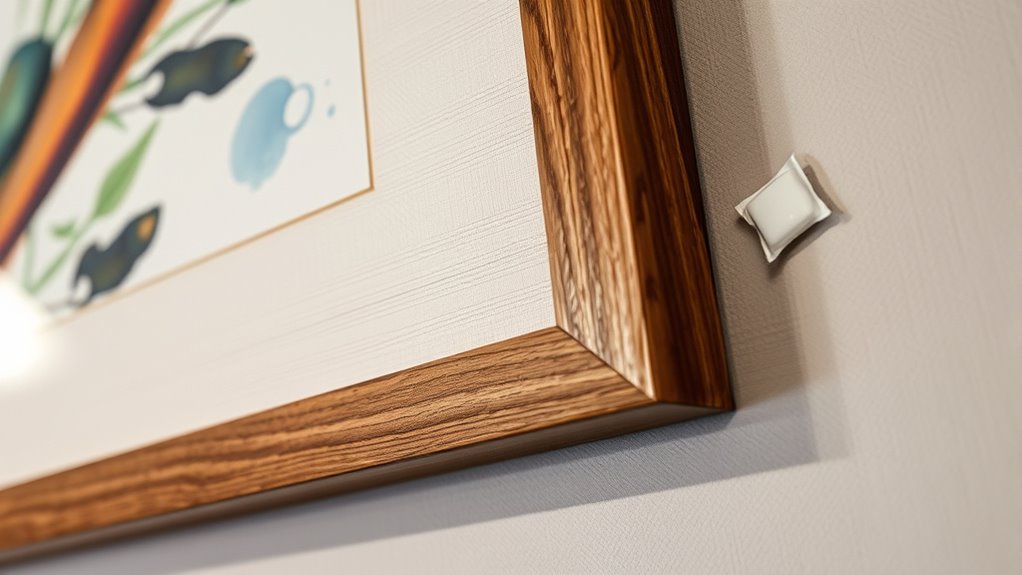
Choosing the right materials and framing is essential when protecting art in humid environments. You should consider moisture-resistant options, appropriate frame sealants, and strategic ventilation to prevent damage. Proper placement and material choices can make a significant difference in preserving your artwork’s integrity. Additionally, utilizing ventilation systems designed for humid spaces can help regulate moisture levels and safeguard your art over time. Implementing moisture barriers within framing can further reduce the risk of mold and deterioration caused by excess humidity. Using humidity control devices can also maintain consistent environmental conditions, further protecting your artwork.
Moisture-Resistant Materials
In humid environments, selecting moisture-resistant materials is essential to protect your artwork from deterioration. Using the right materials helps prevent mold growth and water damage. Consider these options:
- Waterproof coatings: Apply these to walls and framing to create a moisture barrier, safeguarding your art from humidity.
- Mold resistant materials: Opt for mold-resistant drywall or panels that inhibit fungal growth, ensuring a healthier environment.
- Moisture-resistant framing: Use treated wood or metal frames that resist warping and mold, maintaining structural integrity over time.
Frame Sealant Options
Are you selecting the right frame sealant options and materials for humid environments? Choosing proper sealants is vital to prevent moisture infiltration and mold growth around your artwork. Look for sealants labeled as mold-resistant or with excellent adhesion properties suited for high humidity. Silicone-based sealants are popular because they provide flexible, durable, and waterproof seals that resist mold and mildew. Acrylic or latex sealants can work but may need additional mold inhibitors for added protection. Proper application guarantees airtight sealing, preventing moisture from seeping in through gaps. Remember, the right frame materials combined with effective sealants will greatly reduce the risk of mold, protecting your artwork’s integrity over time. Prioritize quality, compatibility, and mold prevention when selecting your framing and sealant options. Additionally, understanding the effects of humidity on materials can help in choosing the most suitable framing and sealing solutions for long-term preservation.
Ventilation and Placement
Selecting the right materials and framing techniques is essential for managing humidity and preventing damage to your artwork. Proper ventilation and placement play a vital role in art conservation and humidity control. To optimize your space, consider these key steps:
- Install a ventilation system that promotes air circulation without creating drafts or fluctuations in humidity. Effective airflow management helps maintain consistent environmental conditions that protect artwork.
- Position artwork away from direct sunlight, windows, and heat sources to prevent temperature swings.
- Use moisture-resistant framing materials, like acid-free backing and sealed glass, to reduce humidity penetration and mold risk.
- Incorporate humidity control measures, such as dehumidifiers or silica gel packs within the room, to further protect your artwork. Additionally, selecting portable power sources for camping, such as portable AC units and power banks, can help maintain stable conditions in outdoor or off-grid environments.
- Ensuring that your storage and display areas have proper climate control is vital for long-term preservation, especially in humid environments.
Implementing Storage Solutions for Art Preservation

Effective storage solutions are vital to safeguarding artwork over time. You should choose art storage containers that offer protection against humidity, temperature fluctuations, and physical damage. Opt for acid-free, padded, and ventilated containers to prevent deterioration. Incorporate climate control systems into your storage area to maintain consistent temperature and humidity levels, which are essential in humid environments. These systems help prevent mold growth and material warping. When selecting storage options, ensure they are sturdy and secure to prevent accidental damage. Properly labeled containers make it easier to organize and access artworks without unnecessary handling. By combining the right art storage containers with effective climate control systems, you create a stable environment that preserves your art’s condition for years to come.
Regular Maintenance and Inspection Procedures
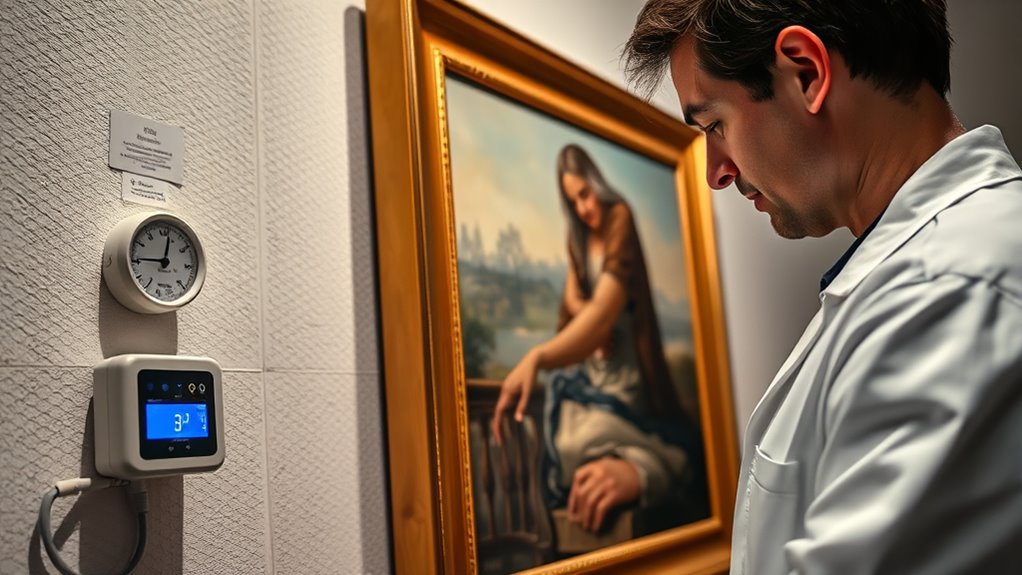
Regular maintenance and inspection are essential to guarantee your artwork remains in ideal condition over time. Consistent checks help identify issues early, supporting effective art conservation and humidity control. To stay ahead, focus on these key steps:
Regular maintenance ensures your artwork’s longevity through early detection and proper humidity management.
- Regularly examine your artwork for signs of moisture damage or mold.
- Calibrate humidity control devices to ensure stable levels.
- Clean display and storage areas to prevent dust buildup and pests.
Emergency Measures for Sudden Humidity Fluctuations
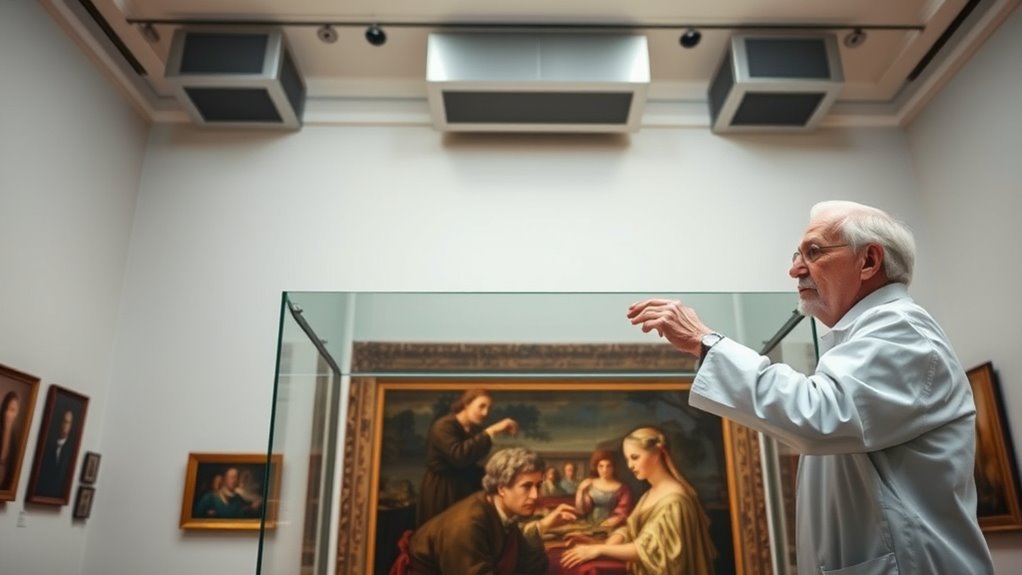
When sudden humidity fluctuations threaten your artwork, swift action is crucial to prevent irreversible damage. Emergency preparedness is your best defense, so establish a plan before crises occur. Quickly assess the situation and identify the source of the fluctuation. Use portable dehumidifiers or humidifiers to stabilize the environment immediately. If the humidity spike is severe, move delicate pieces to a safer, controlled space if possible. Keep a toolkit of essential supplies like moisture meters, fans, and absorbent materials ready for rapid response. Stay calm, act decisively, and implement your emergency procedures without delay. Your quick, informed actions can minimize risks and protect your art from the damaging effects of sudden humidity changes.
Frequently Asked Questions
How Can I Identify Early Signs of Humidity Damage on Artwork?
You can identify early signs of humidity damage by regularly inspecting your artwork for subtle changes like warping, cracking, or discoloration. Use humidity sensors to monitor the environment closely; if levels rise above recommended ranges, damage may soon follow. Watch for mold growth, which often appears as fuzzy spots or stains. Catching these signs early helps prevent irreversible damage and keeps your art in pristine condition.
Are There Specific Paints or Materials More Resistant to Humidity?
Think of your artwork as a ship steering stormy seas; some paints and materials are like sturdy hulls built to withstand the tempest. Humidity resistant paints and moisture proof materials are more resilient, shielding your art from the relentless tide of moisture. Choosing such materials guarantees your masterpiece remains intact, preventing damage from the humid environment. Opt for these specialized supplies to keep your art safe and vibrant over time.
What Are the Long-Term Effects of Improper Humidity Control on Art?
If you neglect proper humidity control, your art faces long-term damage like material degradation and humidity-induced mold. Over time, high humidity causes paint to crack, paper to warp, and colors to fade. Mold growth can ruin your pieces entirely, making restoration difficult or impossible. To preserve your art’s integrity, maintain stable humidity levels, use dehumidifiers, and regularly inspect your collection for early signs of damage.
Can Humidity Fluctuations Cause Irreversible Damage to Certain Art Mediums?
Humidity fluctuations can cause irreversible damage to art, especially with frequent humidity cycles. Studies show that mold growth increases by 30% in environments with unstable humidity, which can lead to staining and deterioration. Rapid changes cause materials to expand and contract, cracking paint or loosening adhesives. You should maintain consistent humidity levels to prevent these issues, as once damage occurs, it’s often permanent and costly to repair.
How Do I Train Staff to Recognize Humidity-Related Art Deterioration?
You train staff to recognize humidity-related art deterioration through thorough staff training focused on humidity awareness. Show them signs like warping, cracking, or mold growth, and explain how fluctuations cause these issues. Use visual aids and hands-on demonstrations to reinforce learning. Encourage them to monitor environmental conditions regularly and report any changes promptly. This proactive approach helps prevent irreversible damage and ensures proper care for delicate art pieces.
Conclusion
By safeguarding your art against humidity’s silent threats, you’re protecting more than just objects—you’re preserving memories, history, and passion. Think of your space as a sanctuary where each piece can breathe freely and flourish. When you act now, you become the guardian of timeless beauty, shielding it from the storms of moisture. Remember, your vigilance is the steady hand that keeps your treasured art alive, vibrant, and eternal amidst the ebb and flow of the elements.
